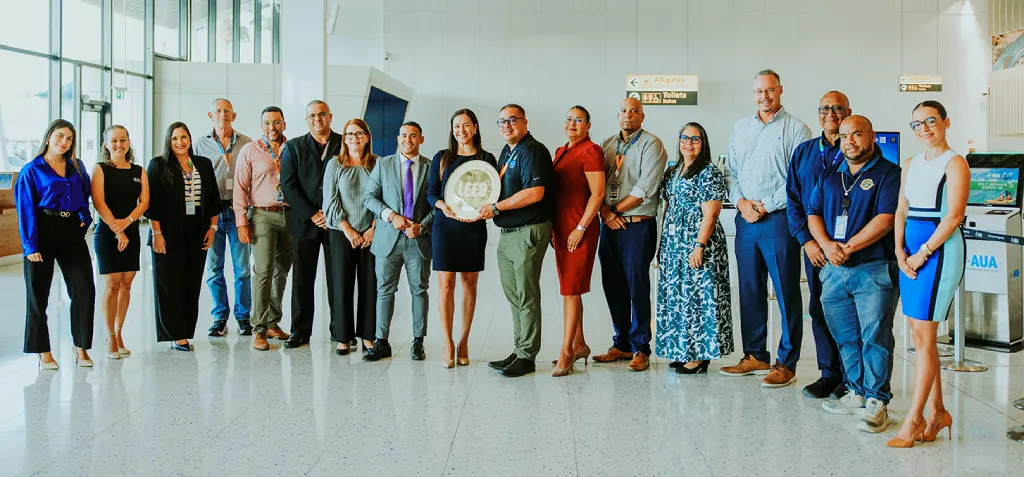
Aruba Airport Authority N.V. (AAA) is proud to announce that Queen Beatrix International Airport’s Gateway 2030 Phase 1A Terminal Expansion project (GW 2030 Phase 1A) has achieved the esteemed LEED Gold Certification as the 1st Airport Terminal in the Caribbean and the 1st LEED Gold Certified new building in Aruba. This achievement marks a significant milestone in the airport’s commitment to sustainable growth and environmental stewardship.
To commemorate this remarkable achievement, Aruba Airport held a small reception on June 26, 2025. The event was attended by the Minister of Tourism, Transport and Labor, Mr. Wendrick Cicilia, members of the Board of Supervisory Directors of Aruba Airport Authority N.V., and Aruba Airport employees who contributed to the realization of this certification. The reception recognized the collaborative effort and shared vision that made this milestone possible, reinforcing Aruba Airport’s role as a leader in sustainable aviation infrastructure in the Caribbean.
LEED (Leadership in Energy and Environmental Design) certification is a globally recognized symbol of excellence in green buildings. LEED certification provides a framework for healthy, highly efficient, and cost-saving green buildings, which offer environmental, social, and governance benefits. To achieve the LEED Gold certification, a possible 60 – 79 points can be earned of which Aruba Airport achieved 68 points.
GW 2030 Phase 1A encompasses a 14,250m² expansion of the US Departures Passenger Terminal, including a new check-in hall, baggage hall, and airline offices. Throughout the project, numerous design choices and innovations were implemented. Key sustainable metrics and measures of GW 2030 Phase 1A include:
- Energy Efficiency: 48% less energy demand compared to the existing terminal building, with 5% renewable energy produced on-site.
- Water Conservation: 24% less water demand and no potable water used for irrigation.
- Waste Management: Over 57% of onsite generated construction waste was diverted from landfills.
- Materials: Use of recycled content and natural materials to enhance indoor air quality and environmental performance.
- Transportation: Provides alternative-fuel stations (EV chargers) for 5.35% of the total parking capacity and low-emitting vehicles
- Alternative Energy: Solar panels and green power purchasing.
- Indoor Environmental Quality: Demand-controlled ventilation, LED lighting, and low VOC materials for a healthy indoor climate
Aruba Airport plays a crucial role in connecting the island with the world and driving economic growth and development for the local community through tourism and job creation. Recognizing the importance of sustainable development, Aruba Airport launched the Gateway 2030 Terminal Expansion project to address capacity constraints and ensure future growth in an environmentally responsible manner.
A Commitment to the Future
With the completion of GW 2030 Phase 1A, Aruba Airport has made significant strides towards creating a green and sustainable airport. Through a strong collaboration between Aruba Airport Authority N.V. and NACO (Netherlands Airport Consultants), the integration of innovative and sustainable design principles to meet the LEED Gold Standards by the LEED certifying body (USGBC) was ensured. The Gateway 2030 Terminal Expansion project will continue to expand, with subsequent phases already underway and aiming for further LEED certifications.
Angeline Flemming, Director of Health and Sustainability stated: “This historical achievement was made possible by the dedication and commitment of the entire company and highlights AAA’s commitment to sustainability, by preparing and executing projects in a responsible way. AAA is keenly aware of its responsibility to operate in the most sustainable way possible, and this includes maintenance and construction of facilities at the airport.”
“Designing and constructing facilities based on Leed principles gives our team clear guidelines to include efficiency and sustainability principles early on in our projects. As a company, we are committed to lowering our power and water consumption and building according to these principles guarantees positive results.” according to Gilbert Rafael, Chief Development &Technology for AAA.
